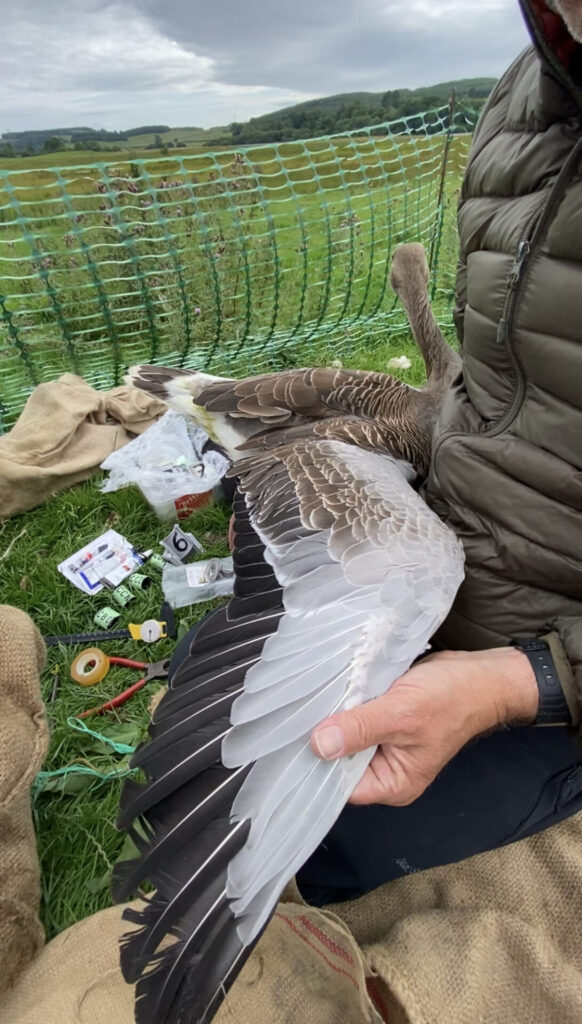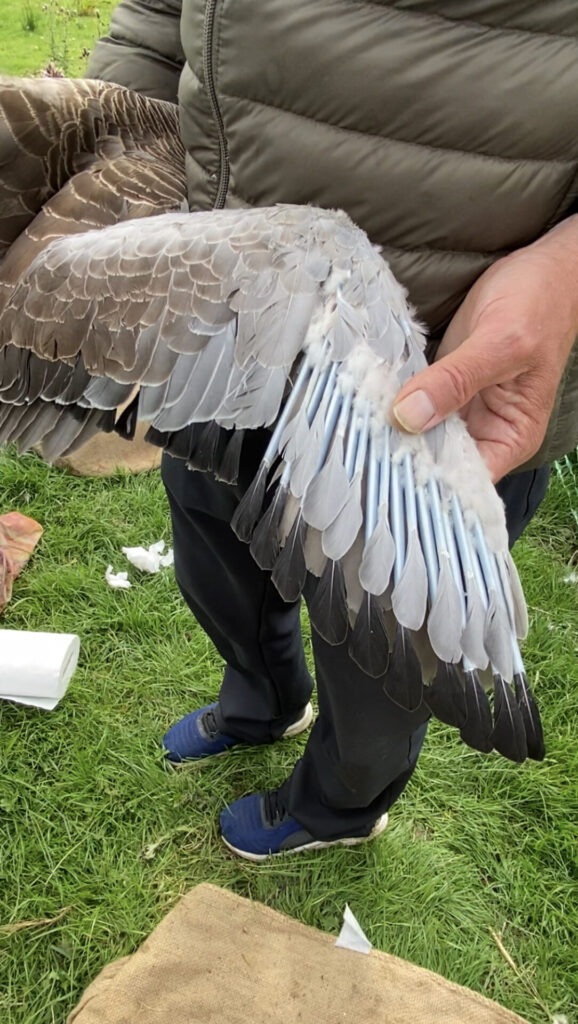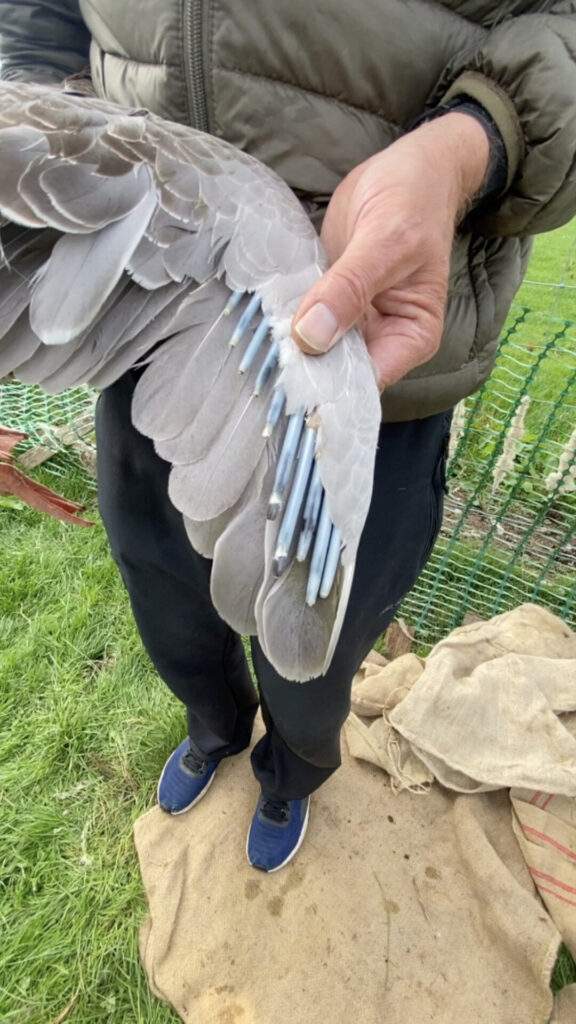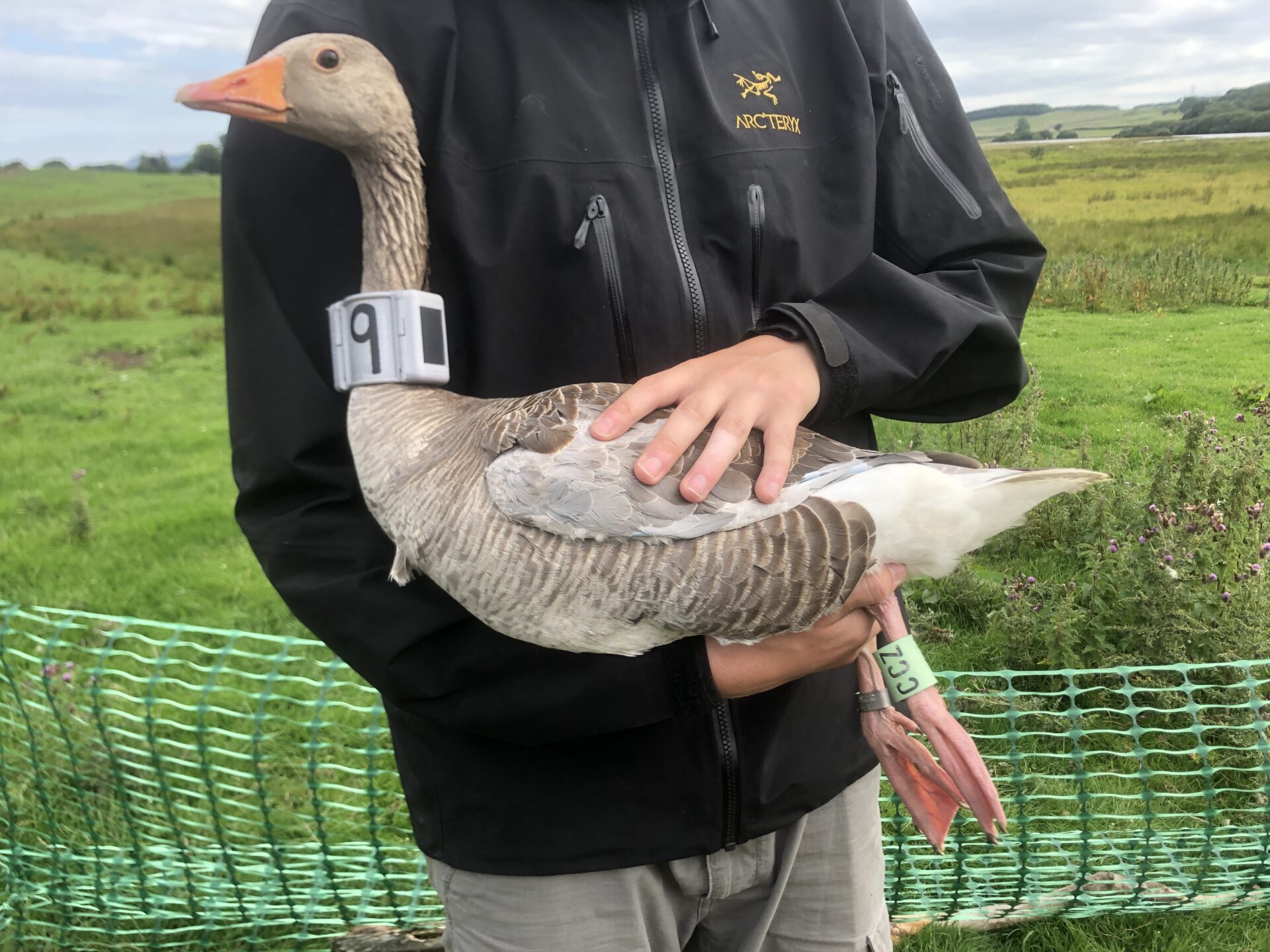Dr Larry Griffin of ECO-LG Ltd, shares his experience of tagging Greylag Geese on Loch Ken earlier this summer.
This took place at a crucial time when the birds are coming out of the major energy/nutrient pinch point of moult while trying to cater for their growing young.
By Dr Larry Griffin
Since GPS collar-tagging the four greylag geese at Loch Ken on 7th July, it has been fascinating over the last two weeks to witness their return to locomotion through flight. When caught, the birds were flightless due to being in moult, with the birds having dropped their primary and secondary flight feathers and being in the process of regrowing them.
We persuaded the birds to run into a pen by surrounding them and cutting off their escape route to the loch. Obviously if a wheezing 50-year-old and his family can corner some canny geese like that, then it shows how moult can be a tricky time of high risk for big birds such as these whether here on Loch Ken or in more remote regions of the Arctic where foxes and polar bears roam.
Usually, such predators rely on stealth and then speed to try and catch a goose, but for us it was a power boat along the loch. Fortunately for the birds, rather than eat them, we only wish to learn more about their ways, and so having sexed them and checked their vital statistics and fitted the GPS collars and leg rings, we were soon releasing them back onto the loch none the worse for wear.
It was very interesting to see how the last bird, a big male behaved on release. Instead of running for the loch as thought, he merely held his head up and honked steadily while strutting along beside us being in no great hurry to get back on the water and looking impressively unbothered by our handling of him!
Also, it was very evident while measuring them, that the moult stage of each goose differed markedly, with the females having either almost fully regrown their flight feathers, or like the male, hardly regrown their feathers at all, being almost fully “in pin”. The pin being like a blood-filled straw or sheath that the feather tip slowly splits out of over a period of a fortnight to three weeks.



From left to right, the fully regrown and 40% regrown flight feathers of two female greylag geese tagged and the early stage of regrowth of the male’s flight feathers which were almost fully “in pin”.
Oddly the fully feathered birds although capable of flight can get caught up in the moment and become part of the “herded flock/bait ball” being rounded up and corralled and seem to forget they can escape the situation by flying; though perhaps some such adults choose not to fly and stay with their young to protect them.
The tagged birds that clearly had the most well-developed wings when in the hand were the first ones to leave the loch, initially heading south to the restored NTS wetlands at Threave for a few days before heading east to either the River Nith near Glencaple and Caerlaverock Estate and RSPB Kirkconnell Merse or to Loch Rutton near Lochfoot and the fields in that area as far south as Beeswing. In these areas the birds are currently feeding on grain residues in the stubble fields exploiting them for a day or two before moving on, following in the wake of the combine harvesters.
As of 11th August, the male that had the least regrowth of its flight feathers when caught, was still residing on pastures near the catch site and was spotted on the 10th with ten other birds in a small flock happily feeding away at Finniness. So far, none of the four newly tagged birds have shown evidence of having young with them.
The male goose that had the most poorly developed flight feathers had possibly been slow to moult because it may well have been protecting a brood of young at some point prior to the catch, and breeders with young are later to moult than failed breeders or those birds still without mates in the spring or that chose not to breed. This is because the breeding adults retain flight capabilities for longer in order to accompany their young to better inland feeding pastures or marshes of greater vegetative nutrient content so that the goslings can put on mass and growth as fast as possible in the short summer period – especially in the Arctic, and to be able to protect the young being able to fly at potential predators or aggressively make themselves look bigger and shield the brood with flicks of their wings.
Moult is a very challenging time, not only because of the direct threat of predation from land mammals or larger birds of prey such as eagles or gyrfalcons in the more northerly Arctic regions, but also because the birds are limited to the feeding areas they can exploit, needing to stay within a short distance of a water body for escape. Therefore, feeding areas are reduced to a narrow strip around the edge of a river or lake or marsh pool and might only be accessible in certain areas where there are no fences, walls or trees and shrubs and where the birds have good views across the surrounding “landscape of fear” to assess for predators, which means good sites for moulting can be limited and thus competition for the best food can be relatively intense. Getting the energy and nutrients for feather regrowth thus becomes a challenge especially if body reserves have already been depleted by trying to protect a brood due to adults having to remain vigilant with their heads up for more of the time rather than with their heads down feeding. This is part of the reason geese like to flock together and are social birds as there is safety in numbers and more eyes to spot possible threats and give an early warning.
For Arctic breeding species such as the pink-footed geese or barnacle geese, considerations about the moult site may mean they travel many 100’s of miles to a safe site with good access to resources and reduced predator numbers, with pink-footed geese from Iceland travelling to the most northerly tip of Greenland for this critical phase of the life-cycle.
Even so many birds can die at this time of year when they are flightless or in poor body condition and the best way to help such geese is to leave them alone, undisturbed and with unimpeded access to foraging areas.
